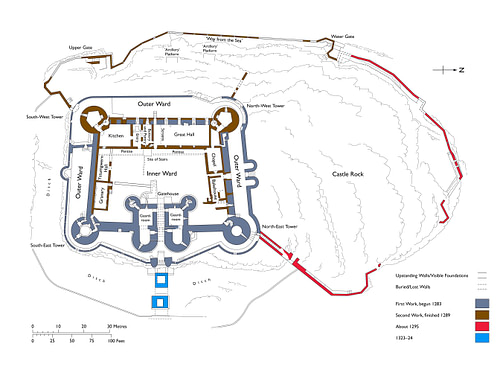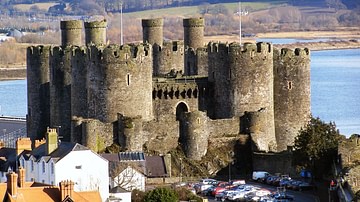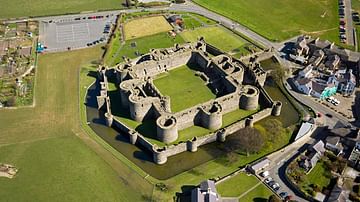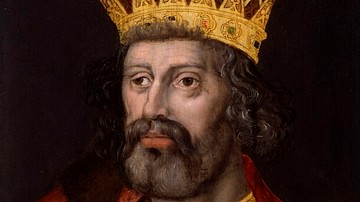
Harlech Castle, located in North Wales, was first built by Edward I of England (r. 1272-1307 CE) from 1283 CE. Largely completed by 1290 CE, the castle received some further additions up to 1330 CE. A classic example of a concentric medieval castle, Harlech skilfully used local topography, the sea, and imposing towers to represent a formidable challenge to any attackers, as proven in the lengthy sieges of the Welsh rebellions and the Wars of the Roses during the turbulent 15th century CE. Harlech Castle is listed by UNESCO as a World Heritage Site.
Edward I's Castle Building
From 1272 CE Edward I, the new king of England, conquered most of Wales and joined it with the county system present in England. Following the death of Llywelyn, the Prince of Wales, in 1282 CE, the only part of Wales which remained free was the wild mountainous north and here the king built several major castles which included Caernarfon Castle, Conwy Castle, and Harlech Castle. Work began on Harlech Castle in June 1283 CE, the vast team of labourers, masons, and craftsmen being supervised by Master James of Saint Georges (c. 1235-1308 CE), the experienced architect and engineer who had previously built castles in Europe and who would be involved in many of Edward's other Welsh castles.
As with any major castle, the choice of location would be the key to its chances of withstanding siege or attacks. Harlech was built on one of the most secure spots any castle was erected upon, sited on a rocky crag which rose straight out of the sea (today the sea has receded). There was also vital access to a small port or quay which meant that in times of trouble the castle could easily be supplied by boats (although one does not envy the porters who had to climb the 100+ steps with their heavy loads). The king visited the site in person to check progress over three days in August 1283 CE, and by the end of the first major building phase, he must have been happy with the results as he made Master James constable of the castle in 1290 CE, a position he would hold until 1293 CE.

Harlech would, by 1303 CE, eventually cost 8,184 pounds to construct (around $11 million today) but that was still a third cheaper than the cost of Caernarfon or Conwy. This is because the castle was both smaller and less ornate in its stonework and design. Even more significantly, the castle used local stone and so avoided the heavy costs of transportation of cumbersome materials. Another 400 pounds were spent on the castle between 1303 and 1330 CE.
Design & Layout
The concentric castle has a compact and (approximately) square floor plan with massive towers at each corner of the inner wall and an even larger double-towered gatehouse on the eastern side. Access to the main gatehouse, its outer doorway protected by two D-shaped towers, was across a bridge (now vanished) which led to a series of three portcullises and two stout doors. In addition, 'murder holes' (machicolations) along this narrow passage ensured that anyone who made it this far could be pelted from above with unpleasant things. The two upper floors of the gatehouse have grand fireplaces and three large windows each on the inner face, suggesting they were used as the chamber of important residents. The first floor also had a chapel.
The large cylindrical south-east and north-east towers each have a basement accessed via a trap door and steep shaft. The spaces would have been used for storage and, if the post-medieval name of the latter is anything to go by - Prison Tower - it was used as a dungeon. The south-east tower, in contrast, was known as the Garden Tower. A postern gate gave restricted entrance to the castle's inner ward bailey, located midway along the north curtain wall. The whole castle was surrounded by a second wall creating the outer bailey. The east and southern sides of the castle were further protected by a wide moat with a precipice protecting the north side and the sea a secure barrier on the west side. There was even a rock-cut ditch laboriously made around the southeast corner, the most exposed of the four corner towers.
Following an attack by Welsh rebels during the brief uprising in the province led by Madog ap Llywelyn in 1294-5 CE, a third stone and lime wall was built which ran down and around the base of the rock on which the castle stands. Within this exterior wall, platforms were created for artillery. There was, too, another gate tower and drawbridge which gave access direct from the sea. In 1323-4 CE two rectangular towers were built to better defend the main access bridge.
The buildings in the inner bailey have all but disappeared but suggestive remains indicate what might have been where. The castle's Great Hall was located in the inner ward next to the northwest tower along the western inner curtain wall and besides the chapel, its great fireplace can still be seen today. The castle's kitchens were built against the opposite corner near the south-west tower, the vital well was against the north wall, and a granary stood by the southern inner wall. Finally, the exterior of the outer south wall has an interesting feature, a purpose-built latrine turret.
Rebellions & Civil Wars
Harlech was briefly the seat of the Welsh Parliament in the early 15th century CE. In 1404 CE, after a siege and the garrison was down to 21 men, it was taken by Owain Glyn Dwr who declared himself Prince of Wales from 1404 to c. 1415 CE and so started a significant rebellion against English rule. The castle had been unable to receive supplies or reinforcements by sea because French and Breton ships, sympathetic to the Welsh cause, patrolled the area. Harlech consequently fell and became the rebel's headquarters and so the seat of the Welsh government.

In 1408 CE the castle was then besieged in turn by forces of the Crown led by no less a figure than the future Henry V of England (r. 1413-1422 CE). Due to the castle's excellent defensive arrangements, it took a constant bombardment of heavy cannons, including the massive 'King's Daughter' cannon (so big it exploded at one point), and a distinct lack of food amongst the defenders, to finally recapture the castle in 1409 CE. Mortimer, the last major rebel against Henry IV's reign (1399-1413 CE), was killed in the action, but Owain Glyn Dwr managed to escape. With the castle's capture, so effectively ended the Welsh revolt that had rumbled on throughout the previous decade, even if it would continue for a few more years yet. Harlech was then extensively repaired and a new entrance bridge completed in 1418 CE (and renovated in 1458-9 CE).
The castle was again involved in international affairs from 1461 CE when it remained loyal to Henry VI (r. 1422-1461 & 1470-1471 CE) for seven years during the Wars of the Roses between the rival Houses of York and Lancaster (1455-1487 CE). However, the captain of the guard, Dafydd ap Evan was obliged, despite a relief force led by Henry's uncle Jasper Tudor (l. 1451-1495 CE) arriving in North Wales, to eventually surrender to the Yorkists on 14 August 1468 CE. The long resistance of the castle's Lancastrian garrison would inspire the traditional song 'The March of the Men of Harlech' which features in the 1964 CE film Zulu when the Welsh soldiers begin singing to match that of the Zulu warriors. Some historians have, though, suggested that the song refers to the earlier siege of 1404 CE.
One final action involving Harlech Castle was during the English Civil War (1642-1651 CE). The castle was held for the Royalists by its constable Colonel William Owen against a siege by the Parliamentarians from 1646 CE but, in the end, the garrison was reduced to just 16 men and so surrendered in 1647 CE.
Repair & Resurrection
From the 17th century CE, the castle slowly fell into a state of disrepair although its picturesque ruins would inspire many artists, notably J.M.W. Turner (1775-1851 CE). Major restoration work only began in the 20th century CE under the auspices of the Office of Works. Since 1986 CE, Harlech castle has been listed, along with three other Welsh castles of Edward I, as a World Heritage Site. Specifically, Harlech and Beaumaris castles were selected because of their "unique artistic achievements for the way they combine characteristic 13th-century double-wall structures with a central plan, and for the beauty of their proportions and masonry" (UNESCO). Today, Harlech Castle is open to the public and managed by Cadw, the Historic Environment department of the Welsh Assembly Government.







